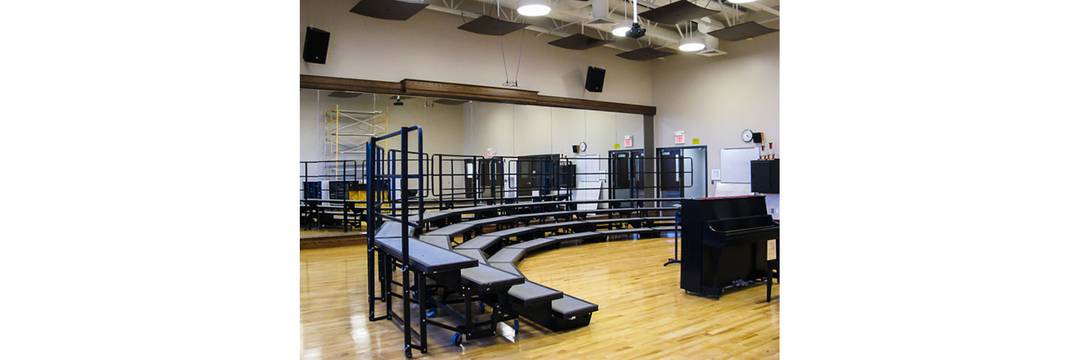
Iowa City High Opens New Performing Arts Wing with Audio Controlled by Q-Sys™ Cores 250i
Affordability and Ease-of-Use Key Factors in Choosing Q-Sys Integrated Cores
Iowa City, IA (February 2013) — City High School in Iowa City, IA, recently opened a new performing arts wing that features Q-Sys™ Core 250i integrated cores in music rehearsal rooms with QSC GX5 power amplifiers powering the installed loudspeakers. The new wing built at a cost of over $6 million is designed to accommodate rehearsal rooms for the band, orchestra and choir and the more than 500 students in the school’s music and performing arts programs. In addition to the rehearsal rooms, the facility hosts a suite of smaller practice spaces, classrooms and other support amenities. Douglass Communications of Ottumwa, IA, provided design and integration services for the installed sound systems.
“We wanted a solution that would enable us to control everything off of an iPad,” explains Matthew Bresch, senior technician and systems designer at Douglass Communications. “So the RS-232 control, to be able to control all of the equipment with the QSC Core, was a huge thing. Once we started looking at Q-Sys, we saw how much simpler it was to program than most of the other DSP programs that are out there.
“What we really like about QSC as a whole is that they have amazing technical support. I spoke with QSC technical support when we were programming the systems probably a dozen times, and each time they were super helpful.” As a contractor, Bresch says, technical support is his number one concern when choosing a manufacturer. “If they won’t return our call or help us when we have issue it doesn’t matter how good their product is. So that was a big thing for me.”
To provide wireless transport control for their Tascam SS-R200 solid state recorder, Tascam CD-500B CD player and iPod docking station, students and teachers use a custom designed user interface on the iPad that was specifically built for City High users. “The iPad interface at City High is super easy to operate”, says Bresch. “A user hits Play on the iPad and it plays a CD; they hit Record on the iPad and it records to the solid state drive from two microphones that hang in the room. So they can record a song that they’re working on as an orchestra and immediately listen back to it.”
The Q-Sys Cores in the two band spaces, which are located downstairs and measure approximately 2,000 square feet each room, also enable room combining when the central divider is removed. “Iowa City High has a big marching band program, so sometimes they need a bigger room,” he adds. Tara Bresch, operations manager for Douglass Communications, designed the custom iPad user control interface using the tools in Q-Sys Designer software. “We gave it a uniform look for all four rooms. There are just two pages, Record and Playback,” she says.
“For the teachers, it was important for it to be consistent in every room, and to be easy, too—because they’re not recording engineers!” she continues. “They’ve got certain things that they want to accomplish very efficiently and very quickly. From the Record page, she elaborates, “The speakers can be muted and the SD recorder un-muted. You hit Record and you’re recording. You can also adjust gain; it’s pretty simple. When you hit the Playback button and you go to the Playback page, the speakers are unmuted and now you can play back the recording, or the CD player, or the iPod dock.”
“We tried to make the interface as simple as possible,” says Matthew Bresch. “All we gave them was a preamp gain, a channel mute, phantom power and a volume control to turn it up or down. We included meters just so that they could see what’s coming in and what’s going out.”
He also reports, “The orchestra teacher is self-proclaimed ‘technically challenged’, and she says she’s using it all the time and has not had one issue, so that’s saying something about the user interface of the Q-Sys system.”